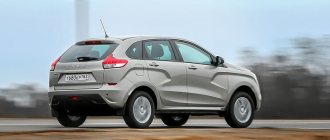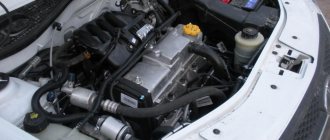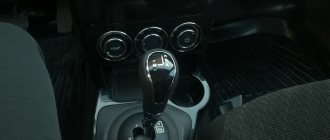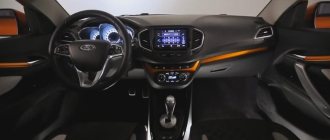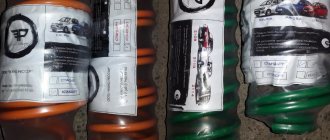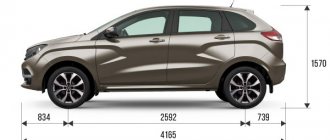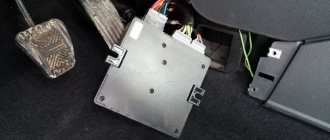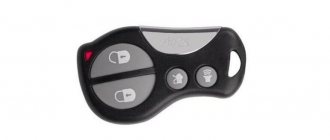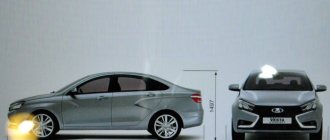The release of the new Russian car Lada Vesta is undoubtedly an important event. Why this car is really qualitatively different from previous Lada models is explained by Sergey Stillavin in the “Big Test Drive” of the Lada Vesta.
It is worth reminding readers that this series of video reviews, dedicated to the development of the Russian automobile industry and testing the qualities of foreign cars, has undoubted authority. The information provided to numerous viewers and fans in the “Big Test Drive” of the Lada Vesta has a high level of relevance due to its receipt directly from the manufacturers.
Gear cycle
The “Big Test Drive” series of Lada Vesta programs began in 2015. To be more precise, the start of filming dates back to the end of January - the model attracted the attention of the program hosts more than six months before the official release. This topic interested both the presenters and the audience so much that it was decided to regularly broadcast information about the new AvtoVAZ model - the Lada Vesta literally gave birth to a whole season of reviews. The video “Big Test Drive” of the Lada Vesta, which is noteworthy, already a week after it appeared on the Internet, received more than ten million views. This can be considered an indicator of the high demand for information about the new Lada model as a whole.
About myths
Almost everything has been clarified, but again, many skeptics who are accustomed to saying that there is nothing good at AVTOVAZ can put forward some theses:
- Foreign cars are made from fully galvanized sheets . Perhaps someone does this (in their barn in particular), but in most industries around the world such sheets are not used. They are soft (do not have the required strength), do not weld well (easily burn through), the cost of the body will go through the roof
- The cold method is used only at AVTOVAZ . This is also not true, for example Chevrolet, KIA, HYUNDAI, TOYOTA, MITSUBISHI use it on many of their cars (even if they are of a budget class, but still). For example, CRUZE is covered worse than VESTA, it does not have sill treatment and some front power struts
- The layer is so thick that it falls off . I really don’t understand who comes up with this idea. If you check with a micrometer, it turns out: the roof is about 105-125 microns, the doors are about 145 microns, the wings are 140 microns, the hood is 110 microns, the trunk lid is 120 microns. This is a complete “pie” that is applied to the steel. It is approximately the same as on many foreign cars of this class and nothing falls off on anyone.
- Only VESTA is processed; other VAZs are not treated ! This is again a myth. Galvanization is applied to the following models: GRANTA (LIFTBACK) - fifth door, fenders (here is the bare minimum of galvanizing), KALINA2 - all external surfaces, except the hood, roof, front and rear side members (fender liners are needed here), PRIORA (since 2009) - everything except the roof, hood. X-RAY - everything outside, except the roof, VESTA - the entire external surface, with the bottom, sills and arches additionally treated with anti-gravel.
As you can see, a lot of things are far-fetched, now I’m providing you with a video version, let’s take a look.
I’ll end with this, I think it was useful, read our AUTOBLOG, subscribe to the channel.
Similar news
- ECO mode | What is this? | New Kia Rio
- Car fresheners
- The engine does not warm up
Add a comment Cancel reply
Description of video reviews
What are we talking about in the “Big Test Drive” of the Lada Vesta? Naturally, the leading programs tried to saturate each episode as much as possible with proven, reliable and interesting information for domestic car enthusiasts. It is worth saying that it was thanks to their first video from the cycle dedicated to Vesta that Russian drivers received a more or less accurate idea of the expected quality level of this model.
In the first episode, the presenters managed to visit the AvtoVAZ concern and not only talk with the responsible designers and technologists, but also see with their own eyes the concept of the Vesta body. At first glance, it was clear that the concern’s approach to creating a car had been significantly changed. It was worth paying attention at least to the dimensions of the body - it is as close as possible to the dimensions of class C cars according to the international classification. The large rear doors immediately caught my eye (as you can see by looking at the photo), providing ease of boarding for passengers - previous models were not so spacious.
The “Big Test Drive” of the Lada Vesta revealed more precise technical details already in the first issue. The viewer learned that standard VAZ engines (1.6 liters, 8 and 16 valves, 86 and 106 horsepower, respectively) and a five-speed Euro gearbox will be used as the power unit.
The number of possible configurations was also clarified - the designers promised the presenters that there would be no more than twelve of them. This information remains true at this point in time: in addition to the basic “Classic” configuration, an improved “Comfort” version is available (which, in turn, can be improved with seven sets of additional options) and the maximum “Lux” version with two powerful sets of add-ons. At the same time, the designers gave some information about what will be included in each of the designated configurations - information that “Lux” and some “Comfort” options will be equipped with an automatic transmission instead of a manual transmission appeared in the very first issue of the “Big Test Drive” Frets of Vesta.
The approximate prices of the configurations, the date of the presentation of Vesta, and the time of its release for sale at official AvtoVAZ dealers have become known. Prices, of course, slightly cooled the interest of domestic drivers in this model - however, it increased again after the “Big Test Drive” of the Lada Vesta in Italy.
The presenters went to Italy in a car provided to them by the concern, where they tested it in action for more than a day. During operation, such important elements of driver and passenger comfort as air conditioning and a radio with built-in audio system received high praise. The advantageous difference between the Euro transmission and the standard VAZ transmission used in previous models was also noted: smooth shifting and almost silent operation evoked well-deserved praise. The presenters were also pleased with the lightness of the steering wheel setting - to correct the course of the car, you don’t need to put in a lot of effort, but the steering wheel does not allow the driver to lose track of the road.
Naturally, the “Big Test Drive” of the Lada Vesta also revealed some shortcomings (which, however, since the release of the Italian edition of the “Big Test Drive” on YouTube, have already been adjusted and corrected by the designers). The most significant of the deficiencies found is the inaccuracy of the built-in ESC system, which is supposed to automatically reduce the vehicle speed to a safe value when entering a turn. As Sergey Stillavin noted, the car continues to adhere to the “turning” speed limit long enough after the car finally leaves it.
In general, the “Big Test Drive” of the Lada Vesta quite adequately assesses the potential of this model, its obvious advantages, and hidden disadvantages. According to recognized automotive experts, the presenters were able to give the new model of the domestic automobile industry a truly objective and accurate assessment, having studied, without exception, all its characteristics that are important for the average Russian driver.
More details about Lada “Vesta” cars
Review of the updated Lada Vesta SW (Station wagon)
Today we will look at a car like the LADA VESTA ST. With the release of the first Vesta, some chuckle when they hear something about Vesta, while others are slowly buying updated cars from AvtoVAZ. Anyone who has driven a sedan at least a little fell in love with this car, which is quite good to drive and also quite comfortable. Finally, VAZ released what they had been waiting for so long - the Lada Vesta in the SW (station wagon) body. In order to understand what we got in the updated version, we will review this model.
First of all, everyone is interested in what is under the hood and how it drives. Let's close this issue and see what we got in the updated Vesta SW. The car is available with power units that will allow you to choose an option tailored to your driving style.
- The first option is a 1.6 liter engine. with a five-speed manual transmission, 106 hp. and a torque of 148 Nm. This option is considered economical. Average consumption per 100 km is 7.3 liters.
- The second option is a 1.6 liter engine. Together, the Jatco six-speed automatic transmission produces 113 hp. and 152 Nm of torque. In this case, you get confident, smooth acceleration and comfortable, quiet movement. Average consumption per 100 km is 7.4 liters.
- The third option is a 1.8 liter engine. with a five-speed manual transmission that produces 122 hp. with a torque of 170 N.m. in this version you have an increased traction reserve. Average consumption per 100 km is 7.8 liters.
- The fourth option, a 1.8 liter engine. and a five-speed automatic transmission, allows you to squeeze out 122 hp. with a torque of 170 N.m. Average consumption per 100 km is 7.6 liters.
All power unit options have EURO-5 toxicity standards.
Car appearance
As for the appearance of the car, it is getting closer and closer to the trends. A beautiful, rapid slope of the roof, which has a small extension in the form of a spoiler, and a “Shark Fin” antenna also appeared on the roof.
One cannot but rejoice at the color scheme of the car. The company offers a sufficient number of body colors, which practically does not limit the buyer’s choice.
The color range includes the following colors:
- The blue color of the pre-storm sky, which has a special, bewitching energy, is called “diving”.
- The white gloss, with the name “Glacial”, goes well with dark body elements and bright red lights.
- Dark brown metallic (Angkor) is a kind of balance between bright colors and the severity of black and gray bodywork.
- Metallic red (Carnelian), perhaps the most energetic color of Vesta SW, perfectly emphasizes the shape of the body and the overall style of the car.
- Phantom. A chameleon color has also appeared in Vesta’s color palette, which shimmers from gold to blue. Creates a mesmerizing effect, as if you are looking at a precious stone.
- Dark gray metallic, this color is always strict and relevant.
- Metallic silver, as in the previous paragraph, is a classic car color.
- The black color gives the car a more solid look and perfectly highlights the chrome moldings.
Interior
Cars with a “Sport wagon (SW)” body are designed for lovers of active recreation, which involves long trips. Based on the car’s focus on long-term use, I really worked hard to ensure that everything was comfortable inside the cabin. In the new, updated Vesta SW, the distance between the front and rear rows of seats has been increased. And also many different niches were added for storing all sorts of small things. Next, we will look at the interior in more detail.
The back row of seats is huge for this class
As for the interior, there are a few cool “chips” for comfort that the Vesta SW has acquired: a heated steering wheel. Heating of the front and rear seats has also appeared, operating in three intensity modes.
The way to the heart of any station wagon is through the trunk. Vesta cannot boast of a wide opening in the luggage compartment; it falls slightly short of one meter. However, the lid opens quite high, about 190 cm, which will protect the heads of tall owners. AvtoVAZ, in this case, did a very good job of organizing the luggage compartment. For the first time, with the release of the station wagon, the luggage compartment is closed by a Euro curtain. It also has various nets that will hold luggage, and there is also a large number of hooks and hooks, which will allow you to secure some cargo. The trunk has 2 lamps and a 12 V charging outlet. A false floor has also been added, consisting of two compartments, small in depth, but still a convenient solution for freeing the trunk from tools and accessories. And below, under these compartments, there is a spare wheel, the niche of which is well sealed with sound insulation. I would like to note that the kit now includes a hydraulic jack, which significantly increases safety when lifting the car.
Luggage compartment organization
To increase space, the rear row of seats can be lowered, which will significantly increase trunk volume, but there is one drawback: when folding the rear seats, a straight floor is not formed, since the seats do not lower to the same level as the main trunk floor.
The rear row of seats has an armrest with two cup holders. The higher roof of the Vesta SW will allow a tall rear passenger to sit comfortably. Also convenient is the decision to make pockets on the front seats, which will allow you to neatly lay out all the necessary things when you are on a long trip. Of course, in the 21st century it’s hard to imagine a person who doesn’t use a smartphone, so for rear passengers there is a 12-volt charger, as well as a USB output, which will allow you to conveniently charge gadgets on the go.
How much this pleasure cost ?
Prices for Lada Vesta SW start from 596,000 rubles to 980 thousand rubles. It all depends on the configuration and terms of purchase. So, you can buy a car with a 1.6 engine, manual, with the basic configuration, at a minimum price, but you will have to pay extra for additional options. And since AvtoVAZ can offer quite a lot of additional options, you can equip the car to the fullest extent, for which you will have to pay a tidy sum.
Prices for Vesta SW 2020
If we compare Vesta and Vesta SW, then the difference in price is not large; the sedan will cost a little less, but will not be able to please the owner with a large number of comfortable features. If we compare the price with the Vesta SW cross, then the basic configuration will be 100 thousand more expensive than just the SW.
Difference from the Cross
Often, when you talk about Vesta SW, people ask again and say, maybe SW Cross? I don’t know what this has to do with the fact that people hear about the cross version more often. Although the difference between the models is small, and in general they can be considered as the same car.
If you think that by taking the cross version you will see significant changes in the interior or exterior design, then you are mistaken. There are minor changes to the interior, which include Cross nameplates, as well as a more colorful interior. The seats in this version are embroidered with inserts in the color of the body and the same color trim on the door cards, plastic inserts of the same color.
The main difference between the Vesta Cross is increased cross-country ability, thanks to the increased ground clearance, which is 203 mm. It is worth noting that the bottom of the car is absolutely flat and covered with plastic protection. This allows you to feel a little calmer off-road. The Cross version also has a reinforced suspension that perfectly absorbs all the potholes on the road. SW Cross is an excellent option for those who often travel outside the city, where the roads are usually unpaved and have a large number of potholes.
Everyone will make a conclusion for themselves whether this car is worth buying. However, Lada can already easily compete with brands such as Kia/Hyundai.
